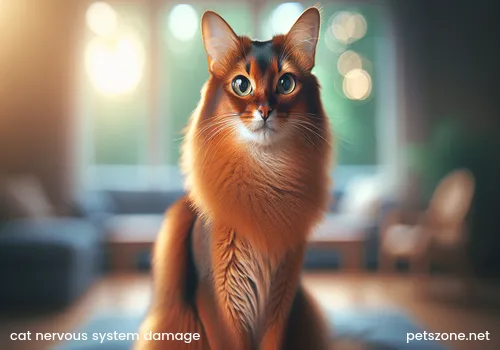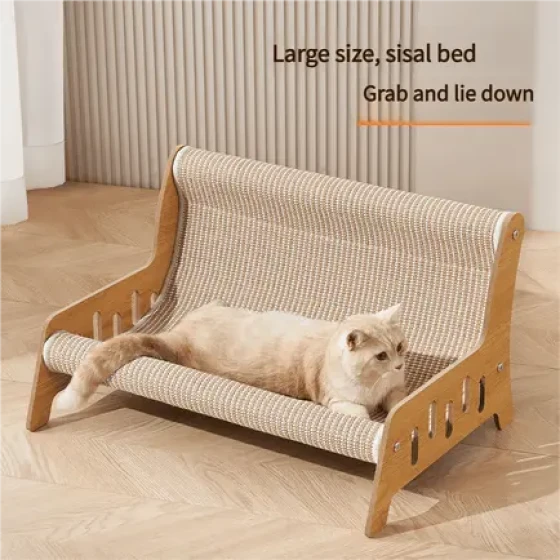Manifestations of Cat Nervous System Damage_ These Abnormal Symptoms Must Not Be Ignored
Cats are good companions for humans, and every move they make touches their owner’s heart. Sometimes, cats may exhibit abnormal behaviors or symptoms, such as unsteady walking, convulsions, strange postures, etc. These may all be manifestations of nervous system damage. Understanding these signs and promptly taking your cat to the vet is vital for protecting your cat's health.
The symptoms of nervous system damage in cats vary depending on the location and severity of the injury. Common abnormal manifestations include but are not limited to:
- Ataxia (unsteady walking): The cat walks unsteadily, like it is drunk, with an uncoordinated gait, easily falling or bumping into things. This may indicate damage to the cerebellum, vestibular system, or spinal cord.
- Epileptic seizures: The cat suddenly falls down, convulses either all over or in parts of the body, foams at the mouth, loses consciousness, sometimes accompanied by urination or defecation incontinence.
- Behavioral abnormalities: Suddenly becoming restless, hiding, attacking without reason, making abnormal sounds, excessive grooming, not recognizing the owner, depression, or mania.
- Balance disorder and loss of sense of direction: Head tilting, body leaning, spinning in place, rapid involuntary back and forth eye movements (nystagmus).
- Limb dysfunction: Weakness or paralysis in one side or multiple legs, stiff gait, dragging paws, or exaggerated gait.
- Sensory abnormalities or pain: Sensitivity to touch, arched back, curled abdomen, resisting being held or touched.
- Eye abnormalities: Unequal pupil sizes, sudden blindness, abnormal eye movements.
- Other symptoms: Loss of appetite, vomiting, difficulty swallowing or breathing, urination or defecation incontinence.
If your cat shows any one or more of the above symptoms, be sure to take it to a veterinarian immediately. Early diagnosis and treatment are crucial to improving the chances of recovery.
Why Does the Cat Nervous System Get Injured?

There are many causes of nervous system damage in cats, some congenital and some acquired. Common pathogenic factors include:
- Trauma: Injuries to the head, spine, or limbs, such as falling from heights, traffic accidents, being bitten by other animals, or accidentally having the tail caught in a door, can all damage the nervous system.
- Infections: Bacterial, viral, parasitic, or fungal infections can affect a cat's nervous system, such as feline panleukopenia virus (which may cause cerebellar hypoplasia), feline infectious peritonitis (FIP) virus, toxoplasmosis, etc. Middle or inner ear infections can also damage the vestibular system and cause balance problems.
- Toxicity: Exposure to certain toxins, heavy metals, insecticides, or adverse drug reactions (such as some dewormers or antibiotics toxic to cats) can cause nerve damage.
- Tumors: Tumors in the brain, spinal cord, nerves, or ears can compress or destroy nerve tissue, causing neurological dysfunction.
- Metabolic diseases: Diabetes, kidney disease, liver disease, hyperthyroidism, or hypoglycemia and other metabolic abnormalities can also affect normal nervous system function. Deficiency of certain vitamins (such as vitamin B12) may cause nerve problems.
- Vascular issues: Brain blood vessel blockage (ischemic stroke) or rupture (hemorrhagic stroke) can injure brain tissue and cause neurological symptoms.
- Congenital diseases: Some cats are born with nervous system developmental abnormalities, such as cerebellar hypoplasia or hydrocephalus. Breeds like Siamese and Burmese cats may inherit vestibular diseases.
- Inflammation: Inflammatory diseases such as neuritis or meningoencephalitis can damage nerve tissue.
- Others: Idiopathic vestibular disease refers to vestibular system dysfunction of unknown cause. Although symptoms are alarming, prognosis is usually good.
Timely Veterinary Care Is Key
When a cat shows nervous system abnormalities, owners must not take it lightly thinking “the cat just twitched” or “maybe it just didn’t sleep well.” These abnormal signals are a “cry for help” from the cat; it may be in pain or experiencing serious underlying problems.
Taking your cat promptly to a veterinary hospital is the right choice. Veterinarians will assess the condition through detailed history-taking, comprehensive physical examination, and neurological evaluation. To identify the cause, the vet may recommend the following tests:
- Blood and urine tests: To evaluate overall health, detect infections, metabolic abnormalities, or toxicity.
- Imaging examinations: X-rays, CT scans, or MRI can help vets observe the cat's brain, spinal cord, and skeletal structures to find trauma, tumors, inflammation, or congenital abnormalities.
- Cerebrospinal fluid analysis: Collecting CSF via lumbar puncture for analysis aids in diagnosing meningitis or encephalitis and other inflammatory diseases.
- Other special tests: Depending on the situation, vets may perform additional tests such as infectious disease screening or toxin detection.
Treatment and Rehabilitation
The treatment plan for cat nervous system damage depends on the specific cause and severity. Vets will create a personalized treatment plan based on the diagnosis, which may include:
- Medication: Antibiotics, antivirals, antiparasitics to treat infections; anti-inflammatory drugs to reduce inflammation; antiepileptic drugs to control seizures; other medications to relieve symptoms and support neurological function.
- Surgery: For certain causes of nervous system problems, such as tumors, spinal cord injuries, or hydrocephalus, surgery may be needed to remove the lesion, relieve pressure, or drain fluid.
- Supportive therapy: Including fluid supplementation, nutritional support, pain management, assistance with urination and defecation (e.g., with cauda equina syndrome), physical therapy, aimed at helping the cat comfortably go through treatment and promote recovery.
- Rehabilitation care: During nerve injury recovery, the cat may require special care such as providing a comfortable living environment, assistance walking and eating, gentle massage, etc.
The rehabilitation process for nervous system injuries can be long and complex, requiring the owner’s patience and attentive care. Some cats can fully recover, while others may have permanent sequelae, such as mild gait abnormalities or head and neck tilt. However, even with sequelae, through scientific care and management, cats can still have a good quality of life.
Frequently Asked Questions
- Are strokes common in cats?
Compared to humans, strokes are not very common in cats, but veterinarians increasingly recognize that the incidence may be higher than previously thought. - What should I do if my cat has a seizure?
Stay calm, remove dangerous objects around the cat to prevent injury. Do not forcibly hold or restrain it. Record the duration and symptoms of the seizure, and if possible, take a video. After the seizure ends, let the cat rest in a quiet, dim place. If seizures last more than 5 minutes or recur in a short time, seek immediate veterinary care. - Is unsteady walking always a neurological problem in cats?
Ataxia is a typical neurological symptom, but other problems like skeletal or muscular diseases may also cause abnormal gait. Vets will determine the specific cause through detailed examination. - Can cat neurological damage be cured?
Treatment outcomes depend on the cause and severity of nerve damage. In some cases, such as those caused by infections or nutritional deficiencies, full recovery is possible with treatment. Congenital or degenerative diseases may require lifelong management and care. - How to prevent nervous system damage in cats?
Although not all neurological problems can be prevented, providing a safe living environment (avoiding falls, traffic accidents), regular check-ups, timely vaccinations, balanced diet, avoiding toxins, and prompt treatment of ear infections can help reduce the risk.
In short, pay attention to your cat's daily behavior and gait. Once abnormalities are detected, especially signs of neurological damage mentioned above, seek professional veterinary help immediately. Your vigilance and prompt action are key to protecting your cat’s health.

-560x560.webp)



